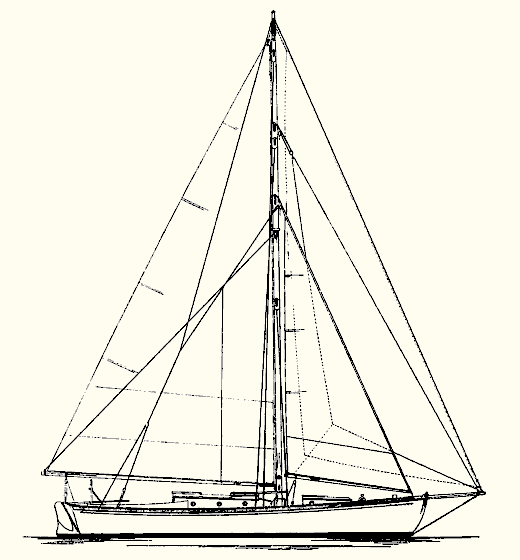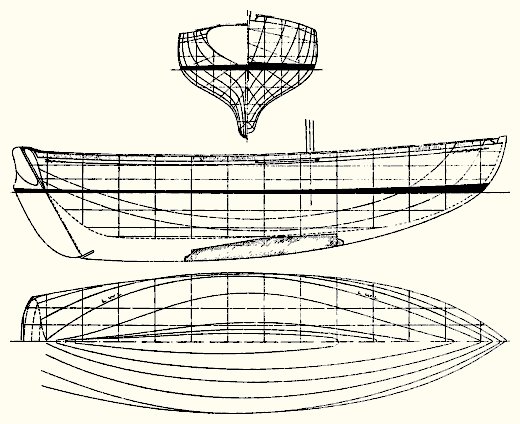

READ in my book, Three Little Cruising Yachts, especially the account of the designing and building of Tally Ho! and thus learn whence comes the inspiration to produce this worthy sister, Tally Ho Major. Tally Ho! is one of those satisfying cruising yachts that bring joy to both owner and designer. And she is in turn a development of still older sisters. Some yachtsman once said that successful yachts just happen. I am not so sure. Most successful things come from application and careful consideration of production of the past; study, deduction, and hard work. However, it seems so to me.
Tally Ho! is a 30-footer; Major is 4 feet 6 inches greater in overall length; 31 feet on the water line; 9 feet 10 inches in breadth; and 4 feet 11 inches draft; much less than her older sister. Thanks to the modest draft, the displacement of Tally Ho Major is only 1,014 pounds greater than that of the 30-footer. With so little difference in the underwater volume one might expect about equal room inside for accommodations in both designs. But it does not work out this way at all. With slightly less freeboard Tally Ho Major has more floor room, more accommodations, more headroom, and more deck room than Tally Ho! And so with nearly equal power in sails and motor she should be as fast as her older sister, as able, and because of greater overall dimensions even more comfortable. The sail area totals 765 square feet distributed in mainsail, staysail and jib.

The deck shows two houses with a husky piece of deck between in the way of the mast. Formerly I always pierced the top of the deckhouse with the mast. This proved to be rather bad practice from several vital standpoints. First, the arrangement is unseaman-like; second, in the long run structurally faulty despite stiffeners, knees, and strapping; third, unhandy for handling sails; and fourth, advantages on the deck more than compensate for slight loss of room below, if below is designed to fit the scheme of things on deck. Which seldom it ever is. Both deckhouses are narrow, giving headroom below where it is needed and providing above strength against wringing strains, and wide decks to walk upon.
The cockpit is 5 feet 3 inches wide by 7 feet 8 inches long. The seats are dropped down below the deck thus providing a nice sense of security and protection from seas and spray. The cockpit is, of course, self-draining. Gasoline tanks of 28 gallons capacity are installed under the cockpit seats, there being two tanks, and on the cockpit floor where any spillage will quickly and safely drain overboard. Place the gasoline shut-off valves at the tanks, and above the floor, then with the fuel shut off there can be no gasoline inside the hull. I always believe in stopping a motor by shutting off its supply of fuel. It is a safe rule to follow.

The cabin is arranged for a party of four. The main companionway leads into the galley, fitted with ample equipment for extended cruising, coal range, ice chest, lockers, galley sink, everything. The motor in this Tally Ho Major, a Gray Four 20, is installed beneath the cockpit floor. It is not crowded into a little cubby hole, inaccessible, and hidden from sight. Rather the room here is exceptional. Doors open from the galley, giving ready access to the motor. In here as well are two large bins for stowage of supplies and gear. Ventilation comes from the hatch in the after deck and the secondary hatch in the cockpit floor. It will be noticed that the center line of the motor is level, no angle whatsoever; and that the shaft splays to starboard, the center of the flywheel being 6 inches to port while the stuffing box is in the center line of the stern post. The advantage of this arrangement is that the propeller stream is deflected in an-opposite direction to the side throw of the propeller and the boat proceeds on a straight course without correction by the rudder. There is nothing experimental about this. Better speed results, there is less vibration, greater fuel economy, and perfect maneuvering qualities. If left-hand propeller is used splay in opposite direction.

The main cabin shows sofas with box berths forming their backs. Dining table of the drop-leaf variety is fixed before the L end of the starboard sofa; all comfortable and snug for happy living. Extra water tanks are located beneath the sofas. The headroom here is 6 feet in the clear with 3 inches additional under the companion slide and skylight.
The space between the main cabin and forward cabin is 3 feet 3 inches long, with 4 feet 6 inches headroom. Here are lockers for hanging clothes. The toilet room is 3 feet 5 inches long with 6 feet of headroom in the standing portion, the water closet being partially under the main deck. With the toilet room door standing open and closing off the main cabin there is plenty of room for washing and shaving.
The forward cabin houses two built-in berths 6 feet 3 inches long by 2 feet 2 inches wide; and under these stowage room. A fresh water tank of 40-gallon capacity is under the fore end of the berths with chain locker abaft this and somewhat lower in the bilge. An open locker occupies the forepeak.

The lines show an easily driven hull having great thickness through the garboards, a wholesome underwater profile with reasonable forefoot depth, slight tumble home to the topsides, and a rather straight sheer. Somehow a bold sheer line is out of place with the modern cutter rig. The bow and stern overhangs balance and, of course, the rudder is hung on the transom which is the proper location for it, and the most scientific. The lead keel weighs 8,640 pounds, and there are also 2,000 pounds of inside ballast located as indicated in the construction drawings.
The construction is husky but not heavy and all materials specified should be of the best quality. In building any boat, blue prints made from the architect's original drawings are invaluable. If the plans of Tally Ho Major as drawn do not meet your requirements, do not change the plans. Rather look at the many other plans of all types which are available in the Atkin site.